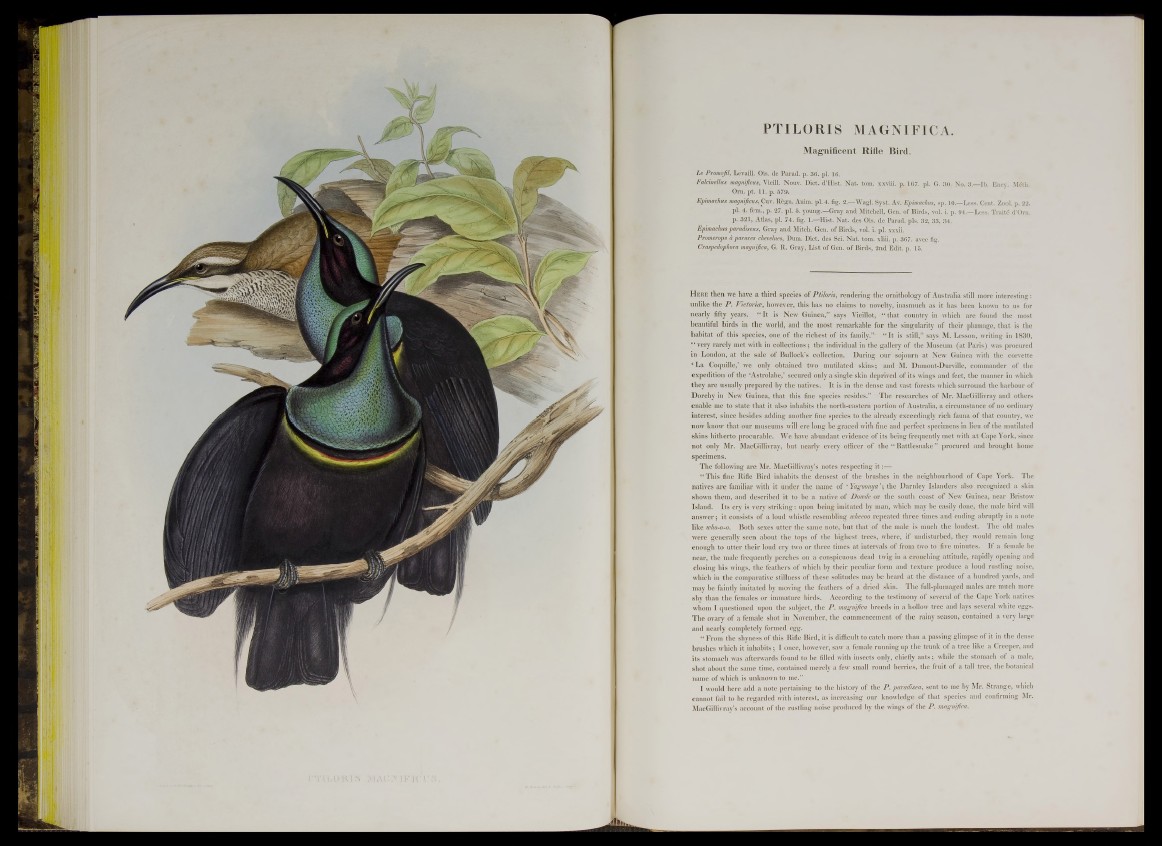
PTILORIS MAGNIFICA.
Magnificent Rifle Bird.
Le Promefil, Levai!! Ois. de Parad. p. 36. p! 16.
Falcinellus magnificus, Yieill. Nouv. Diet. d’Hist. Nat tom. xxviii. p. 167. p! G. 30. No. 3.—Ib. Ency. Méth.
Om. pt. 11. p. 579.
Epimachus magnificus, Cuv. Règn. Anim. p! 4. fig. 2.—Wag! Syst. Av. Epimachus, sp. 10.—Less. Cent. Zoo! p. 22.
p! 4. fem., p. 27. p! 5. young.—Gray and Mitchell, Gen. of Birds, vo! i. p. 94.—Less. Traité d’Om.
p. 321, Atlas, p! 74. %. 1.—Hist. Nat. des Ois. de Parad. pis. 32, 33, 34.
Epimachus paradiseus, Gray and Mitch. Gen. of Birds, vo! i. p ! xxxii.
Promerops à parwres chevelues, Dum. Diet, des Sei. Nat. tom. xliii. p. 367. avec fig.
Craspedophora magnifica, G. R. Gray, List of Gen. of Birds, 2nd Edit. p. 15.
H e r e then we have a third species of Ptiloris, rendering the ornithology of Australia still more interesting:
unlike the P . Victoria, however, this has no claims to novelty, iuasmuch as it has been known to us for
nearly fifty years. “ It is New Guinea,” says Vieillot, “ that country in which are found the most
beautiful birds in the world, and the most remarkable for the singularity of their plumage, that is the
habitat of this species, one of the richest of its family.”- “ It is still,” says M. Lesson, writing in 1830,
“ very rarely met with in collections; the individual in the gallery of the Museum (at Paris) was procured
in London, at the sale of Bullock's collection. During our sojourn at New Guinea with the corvette
‘La Coquille,’ we only obtained two mutilated skins; and M. Dumont-Durville, commander of the
expedition of the ‘Astrolabe,’ secured only a single skin deprived of its wings and feet, the manner in which
they are usually prepared by the natives. It is in the dense and vast forests which surround the harbour of
Dorehy in New Guinea, that this fine species resides.” The researches of Mr. MacGillivray and others
enable me to state that it also inhabits the north-eastern portion of Australia, a circumstance of no ordinary
interest, since besides adding another fine species to the already exceedingly rich fauna of that country, we
now know that our museums will ere long be graced with fine and perfect specimens in lieu of the mutilated
skins hitherto procurable. We have abundant evidence of its being frequently met with at Cape York, since
not only Mr. MacGillivray, but nearly every officer of the “ Rattlesnake ” procured and brought home
specimens.
The following are Mr. MacGillivray’s notes respecting i t :—•
“ This fine Rifle Bird inhabits the deusest of the brushes in the neighbourhood of Cape York. The
natives are familiar with it under the name of ‘ Yagoonya the Darnley Islanders also recognized a skin
shown them, and described it to be a native of Dotode or the south coast of New Guinea, near Bristow
Island. Its cry is very striking: upon being imitated by man, which may be easily done, the male bird will
answer; it consists of a loud whistle resembling wheeoo repeated three times and ending abruptly in a note
like ioho-o-o. Both sexes utter the same note, but that of the male is much the loudest. The old males
were generally seen about the tops of the highest trees, where, if undisturbed, they would remain long
enough to utter their loud cry two or three times at intervals of from two to five minutes. If a female be
near, the male frequently perches on a conspicuous dead twig in a crouching attitude, rapidly opening and
closing his wings, the feathers of which by their peculiar form and texture produce a loud rustling noise,
which in the comparative stillness of these solitudes may be heard at the distance of a hundred yards, and
may be faintly imitated by moving the feathers of a dried skin. The full-plumaged males are much more
shy than the females or immature birds. According to the testimony of several of the Cape York natives
whom I questioned upon the subject, the P . magnifica breeds in a hollow tree aud lays several white eggs.
The ovary of a female shot in November, the commencement of the rainy season, contained a very large
and nearly completely formed egg.
“ From the shyness of this Rifle Bird, it is difficult to catch more than a passing glimpse of it in the dense
brushes which it inhabits; I once, however, saw a female running up the trunk of a tree like a Creeper, and
its stomach was afterwards found to be filled with insects only, chiefly an ts; while the stomach of a male,
shot about the same time, contained merely a few small round berries, the fruit of a tall tree, the botanical
name of which is unknown to me.”
I would here add a note pertaining to the history of the P . paradisea, sent to me by Mr. Strange, which
cannot fail to be regarded with interest, as increasing our knowledge of that species and confirming Mr.
MacGillivray’s account of the rustling noise produced by the wings of the P . magnifica.